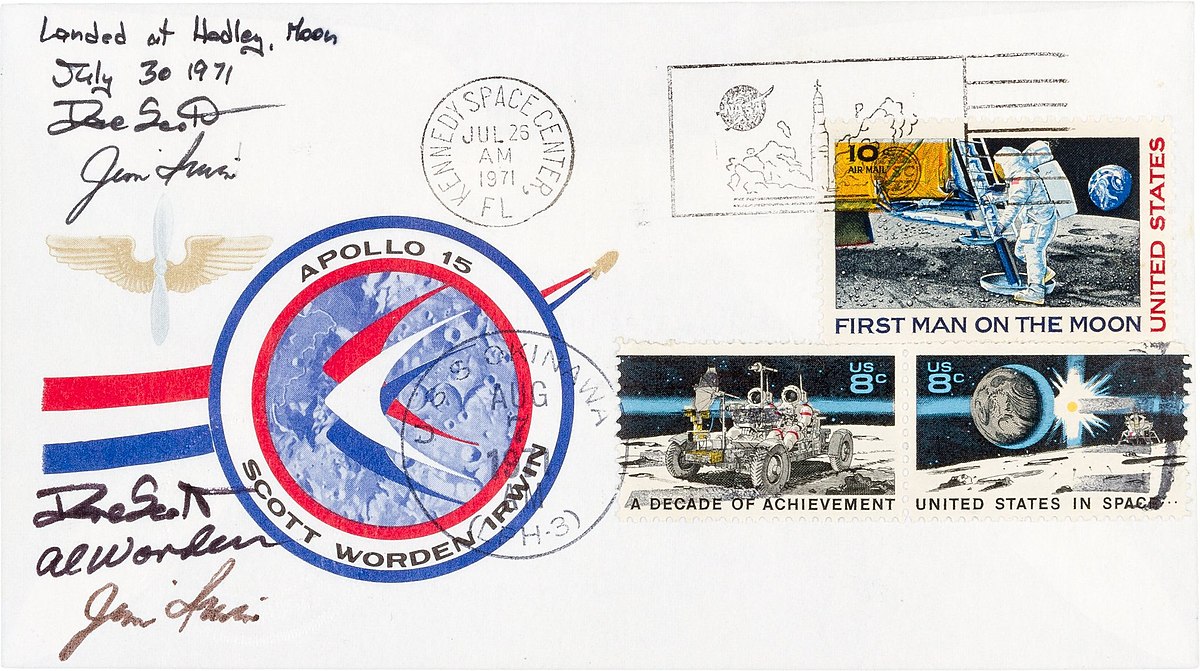In the annals of space exploration, the Apollo 15 mission is often celebrated for its numerous achievements, including the first use of the lunar rover and the longest stay on the Moon’s surface at that time. However, this mission is also remembered for a scandal that rocked NASA and tainted the reputations of three astronauts—David Scott, Alfred Worden, and James Irwin. This scandal, known as the Apollo 15 postal covers incident, unfolded in 1972 and involved the unauthorized carriage of about 400 postal covers to the Moon’s surface aboard the Lunar Module Falcon.
The Whole Story of the Scandal
The postal covers, which are envelopes typically with commemorative stamps, were carried into space without the knowledge or authorization of NASA. These covers were later sold at high prices by West German stamp dealer Hermann Sieger and became known as ‘Sieger covers.’ The three astronauts, along with an acquaintance named Horst Eiermann, had entered into an agreement to have these covers made and taken into space, with each astronaut set to receive approximately $7,000—a significant sum at the time, and equivalent to about $51,000 in 2023.
The arrangement was shrouded in secrecy. On the morning of the Apollo 15 launch on July 26, 1971, the covers were postmarked, packaged for space, and delivered to Scott, who concealed them in a pocket of his space suit. These covers spent several days on the Moon, from July 30 to August 2, inside the Lunar Module Falcon. Upon the mission’s return to Earth and the splashdown on August 7, the covers were postmarked again on the recovery carrier USS Okinawa. One hundred of these covers were sent to Eiermann, who passed them on to Sieger, while the remaining were divided among the astronauts.
Their involvement with the covers did not remain secret for long. In late 1971, NASA became aware that additional covers carried by Worden for another acquaintance, F. Herrick Herrick, were being sold. This prompted Deke Slayton, the astronauts’ supervisor, to warn Worden against further commercialization of items taken into space. However, by then, the Sieger arrangement had already been made, and despite the astronauts returning the compensation they had received, they were removed from their positions as backup crew members for Apollo 17. The scandal broke into the public domain in June 1972, with widespread press coverage casting the astronauts in a negative light.

The Consequences and Implications of the Scandal
The fallout from the scandal was significant. All three astronauts were reprimanded by NASA and called before a closed session of a Senate committee. The controversy effectively ended their spaceflight careers, as none of them flew in space again. By 1977, all three had left NASA. In a twist of fate, in February 1983, Worden sued the government, alleging that the seizure of the envelopes without a hearing had violated the Constitution. The Department of Justice, concluding it had no grounds to contest the suit, returned all the covers in an out-of-court settlement in July 1983. One of the Sieger covers later sold for over $50,000 in 2014, a testament to the enduring fascination with space memorabilia.
Apollo 15 postal covers scandal serves as a cautionary tale about the intersection of personal gain and professional duty. It highlights the complexities of navigating ethical boundaries in the uncharted territories of space exploration. The incident also underscores the immense value placed on space-flown items by collectors and the potential for such items to become embroiled in controversy.
In the wake of the Apollo 15 postal covers scandal, the consequences for the astronauts involved were both immediate and long-lasting. The scandal not only brought an abrupt end to the spaceflight careers of David Scott, Alfred Worden, and James Irwin but also cast a shadow over NASA’s public image during a time when the agency was celebrated for its groundbreaking achievements in space exploration.
The aftermath of the scandal was a period of intense scrutiny for NASA. The agency, which had been riding the high of successful lunar missions, was now faced with questions about its oversight and the conduct of its astronauts. The reprimands handed down to Scott, Worden, and Irwin were a clear message that NASA would not tolerate any actions that could be perceived as undermining the integrity of the space program. The astronauts’ removal from their positions as backup crew members for Apollo 17 was a significant professional setback, effectively ending their prospects for future spaceflights.
The Senate committee’s closed session, which the astronauts were called before, was a testament to the seriousness with which the matter was treated. The fact that the astronauts never flew in space again speaks volumes about the severity of the breach of trust. The scandal also prompted a reevaluation of NASA’s policies regarding personal items taken into space, leading to stricter controls and greater transparency.
The legal battle that ensued years later, with Worden’s lawsuit against the government, highlighted the ongoing repercussions of the incident. The out-of-court settlement in July 1983, which saw the return of the covers to the astronauts, was a small measure of vindication for Worden. However, it could not undo the damage to the astronauts’ reputations or restore their lost careers in space exploration.
The enduring fascination with space memorabilia, as evidenced by the high prices fetched by the Sieger covers, underscores the unique allure of items that have traveled to space. The sale of one of the Sieger covers for over $50,000 in 2014 (equivalent to $64,000 in 2023) is a testament to the value collectors place on such artifacts. This fascination, however, comes with its own set of ethical considerations, as the Apollo 15 scandal so starkly illustrated.
The legacy of the Apollo 15 postal covers scandal is multifaceted. On one hand, it serves as a cautionary tale about the temptations that can arise when extraordinary opportunities intersect with personal financial interests. On the other hand, it is a reminder of the human element in space exploration—the astronauts, despite their heroism and achievements, were not immune to lapses in judgment.
The scandal also had implications for the field of astrophilately. The unauthorized carriage of the postal covers to the Moon’s surface highlighted the need for clear guidelines and ethical standards in the collection and sale of space-related philatelic items. The incident likely made collectors and dealers more cautious, and perhaps more appreciative of the provenance and legitimacy of space-flown items.
In the broader context of space exploration history, the Apollo 15 postal covers scandal is a small but significant chapter. It is a story that reflects the complexities of human nature, the challenges of maintaining ethical standards in uncharted territories, and the enduring human fascination with space and the artifacts associated with it.
As we continue to push the boundaries of space exploration, the lessons learned from the Apollo 15 scandal remain relevant. They remind us of the importance of upholding the highest standards of conduct, the value of transparency, and the need to balance personal interests with professional responsibilities. The scandal also serves as a historical footnote that adds depth to our understanding of the Apollo era—a time of great triumphs and, as it turns out, some notable tribulations.
Related posts:
Apollo 15 postal covers incident
Apollo 15’s Al Worden on Space and Scandal
What is the tech stack behind Google Search Engine?





